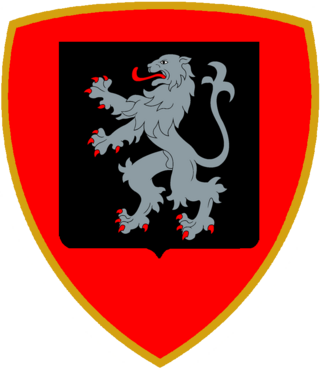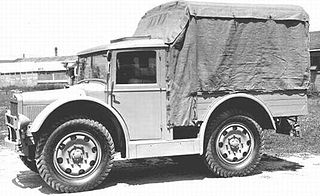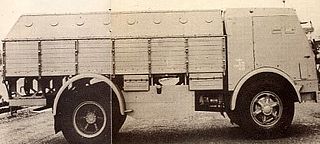History
Since 1938, within the Royal Italian Army, there was emerging a requirement for a transport vehicle for the troops and for the Bersaglieri infantry regiments of the armored divisions. The Viberti introduced since in 1941 a prototype based on the SPA Dovunque 35 truck, however, technical doubts (the excessive weight of the armor on the chassis) and doctrinal questions on the use of such vehicle not turned the project into a contract. The prototype remained in Viberti workshops until 11 November 1944, when it was requisitioned by the Black Brigade Ather Capelli of Turin. [1]
Meanwhile, in 1942 the final version was set, with the top of the transport compartment covered. With the pressure of events in April 1945, the samples still being built at Viberti workshops, both covered top version and uncovered, were requisitioned by the various factions. At least three were taken by Republicans of the Social Republic. Two vehicles were captured by the Italian partisans, one was destroyed by a Panzerfaust from a legionary of the 29th Waffen Grenadier Division of the SS (italienische Nr. 1) (the Italian SS division). [2]

The Carro Armato M15/42 was the last Italian medium tank produced during World War II. It was based on the earlier M13/40 and M14/41 medium tanks, and was built with the lessons from the North African Campaign in mind. The tank was meant to be a stopgap until the heavier P26/40 tank could be produced in numbers. It did not serve in North Africa, the theatre in which it was intended to operate, but served in Italy and in Yugoslavia with the German Wehrmacht.

The M 14/41 was a four-crew medium tank that served from 1941 in the Royal Italian Army. The official Italian designation was Carro Armato M 14/41. The tank was first employed in the North African Campaign where its shortcomings quickly became apparent.

The Autoblindo 40, 41 and 43 were Italian armoured cars produced by Fiat-Ansaldo and which saw service mainly during World War II. Most autoblinde were armed with a 20 mm Breda 35 autocannon and a coaxial 8 mm machine gun in a turret similar to the one fitted to the Fiat L6/40, and another hull mounted rear-facing 8 mm machine gun.

The Ansaldo 105/25 M43, also known as Semovente 105/25, was an Italian self-propelled gun used during World War II and designed by Ansaldo. It was the most powerful self-propelled gun built by Italy in numbers during World War II.

The Auto-Saharan Companies were Italian military units specialised in long range patrols of the Sahara Desert. The units operated from the late 1930s to the Italian surrender in 1943.

The Mechanized Brigade "Aosta" is a mechanized infantry brigade of the Italian Army based on the island of Sicily. The Brigade is one of the oldest of the Italian Army and the name connects the brigade to its original area of recruitment the Aosta Valley and therefore the brigade's coat of arms is modeled after the coat of arms of Aosta. The brigade is part of the Division "Acqui".

The Camionetta Desertica Model 42 was an Italian reconnaissance car of World War II. The AS.42 was developed by SPA-Viberti using the same chassis as the AB 41 armoured car, including its four-wheel steering, but with a 2x4 transmission specifically for desert operations, primarily in a reconnaissance role. Its origins trace back to requests stemming from units operating on the North African front for a long range, highly maneuverable vehicle, similar to those widely used by the highly successful British reconnaissance and raiding force, the Long Range Desert Group (LRDG).

The SPA AS.37 was an Italian military light truck, used during World War II. The AS.37 Autocarro Sahariano was developed from 1937 on the frame of the TL.37 artillery tractor and was especially conceived to be employed in the North African desert. The most significant improvement of this new vehicle was its increased range: 900 km with added water tanks. The A.S.37 could transport 8 men and their equipment in its rear cargo box.

The TL.37 was an Italian military artillery tractor of World War II. It was manufactured by SPA, an Italian car maker that was a subsidiary of Fiat.
The Lancia Ro, Lancia Ro-Ro and Lancia 3Ro were 4x2 heavy trucks built by Italian manufacturer Lancia from the 1930s through the 1940s for military and civilian use. The 2-cylinder diesel Ro was produced from 1933 to 1939, the 3-cylinder diesel Ro-Ro from 1935 to 1939 and the improved 5-cylinder diesel 3Ro from 1938 to 1947.

Auto-Saharan Companies (in Italian Compagnie Auto-Avio Sahariane were special Italian units of desert warfare operating in Libya and Sahara desert during Second World War. Their military operations took place in Egypt, Libya and Tunisia, until the surrender of Italo-German forces in May 1943.

After World War II the Italian Army had two units named "Centauro": from 1952 to 1986 the Armored Division "Centauro" and from 1986 to 2002 the Armored Brigade "Centauro". Both units were successor to the World War II era 131st Armored Division "Centauro". The units' name came from the mythological race of half human-half horse creatures named Centaurs.

The 132nd Armored Brigade "Ariete" is currently the only active armored brigade of the Italian Army. Its core units are tank and Bersaglieri regiments. The brigade's headquarters is in the city of Pordenone and most of its units are based in the North-East of Italy. The brigade's name comes from the battering ram. The brigade draws much of its historical traditions from the 132nd Armored Division "Ariete", which fought in the Western Desert Campaign of World War II. In 1948 the Ariete was reconstituted as division and remained active until 1986. Today the brigade is part of the Division "Vittorio Veneto".

The Mechanized Brigade "Mantova" was a mechanized brigade of the Italian Army. Its core units were mechanized infantry battalions. The brigade's headquarters was in the city of Cividale del Friuli and all the brigade's units were based in the region of Friuli-Venezia Giulia. In 2003, the "Mantova" was raised again as a division command.

The Motorized Brigade "Cremona" was an infantry brigade of the Italian Army. The brigade's headquarters was in the city of Turin. The brigade carried on the name and traditions of the 44th Infantry Division "Cremona".

The Mechanized Division "Folgore" was a mechanized division of the Italian Army. Its core units were three mechanized brigades. The brigades headquarters was in the city of Treviso.

The Fiat 666 was a heavy truck produced by the Italian Fiat Veicoli Industriali.

The SPA 35 is an Italian light off-road truck vehicle produced in Italy by S.P.A. and used by the Royal Italian Army and the Regia Aeronautica during World War II and by the Italian Army in the postwar period. Dovunque is Italian for "anywhere" signifying that the vehicle is capable of travelling cross-country, "35" refers to the year of production.

The Fiat 665NM protetto (protected) or scudato (shielded) was a wheeled armoured personnel carrier, produced in Italy and employed during World War II by the Royal Italian Army, the National Republican Army and the Wehrmacht.

The Breda 51 was an Italian multi-purpose off-road vehicle developed in the 1930s.
This page is based on this
Wikipedia article Text is available under the
CC BY-SA 4.0 license; additional terms may apply.
Images, videos and audio are available under their respective licenses.




















